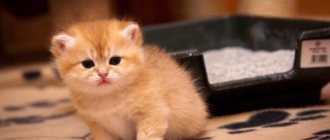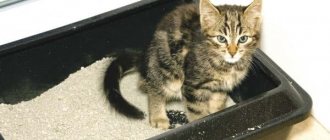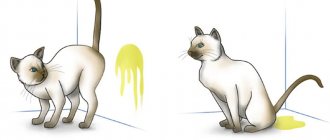Peeing problems are very common in cats, and the behavior can be so distressing for cat owners that it makes some consider returning their pets to where they came from.
Before you go down this route, you should know that there is hope to solve the problem and teach your cat to specifically pee and poop in the litter box.
Not only can you learn the best way to deal with your cat's toileting problems, but you can also learn how to prevent some urinary problems.
Medical problems
If your cat is peeing outside the litter box, the first step is to visit the veterinarian. The veterinarian will perform a physical examination of your pet and test a urine sample.
Based on the results, the veterinarian will recommend treatment. There are a number of common urinary problems in cats:
Bladder stones:
Some cats develop actual bladder stones, which can cause irritation and even blockage of the duct. If your vet suspects bladder stones, you will need an x-ray to determine their size and number.
Small bladder stones can be dissolved with a special diet, while larger ones can be removed surgically (cystotomy).
Idiopathic cystitis:
The term cystitis means inflammation of the bladder. Idiopathic means the cause is unknown. Cats with cystitis often have blood in their urine. A urine test is necessary because blood can only be detected microscopically.
If your veterinarian determines that your cat's urine contains blood but no bacteria or stones, the likely diagnosis is idiopathic cystitis. Idiopathic cystitis is usually treated with dietary changes. Painkillers and sedatives may also be used.
Metabolic diseases:
symptoms of chronic kidney disease may include increased urination. Other metabolic diseases that can increase the amount a cat urinates are liver disease, diabetes, and thyroid problems.
Urinary tract infections or UTIs:
Although urinary tract infections are rare in young cats, they can be a common cause of urinary problems in older cats, either alone or in combination with other diseases affecting the urinary system.
Antibiotics are used to treat urinary tract infections. Your veterinarian will likely recommend repeat tests after the antibiotics are finished to make sure the infection is gone.
What to do if your cat is sick?
When one or more urinary problems are chronic, the condition is usually called feline lower urinary tract disease.
If your cat is diagnosed with this condition, your veterinarian may recommend a special urinary diet and/or supplements to support the urinary tract.
Problems with urination can lead to severe urinary obstruction, especially in cats. If she is having trouble urinating, don't delay a trip to the vet.
If your cat strains to urinate and little or no urine comes out, she may have a blockage or partial obstruction.
If this occurs, contact your veterinarian immediately as this condition can quickly become life-threatening.
In some cases, a cat does not urinate in the litter tray when it has health problems not related to the urinary system. Your cat may urinate outside the litter box due to pain or discomfort in other parts of the body.
This is a reason to undergo a comprehensive examination. Laboratory tests can reveal serious health problems such as diabetes or kidney disease, allowing your veterinarian to begin treatment immediately.
How to toilet train a kitten
What could be better when a cat goes to the toilet on its own? There is no need to buy fillers, change them, or wash pots. Training a kitten to use the toilet is not an easy process . While the pet is small, it will not be able to jump to such a height on its own, and there is no point in putting it there by force - you will achieve nothing but fear from the animal.
The process should begin when the cat is 5-6 months old. They do it this way:
- Bring the tray into the restroom and place it next to the toilet.
- When the cat gets used to it and calmly goes to the toilet in a new place, begin to gradually lift the container. You can put newspapers (magazines, old books) or something else under it. Once a week, increase the height of the container by a few centimeters.
- Having thus brought the container to the level of the toilet, start leaving it, for example, overnight, right on top: fold back the lid with the toilet seat and place the tray in the space. By this time, your pet should be able to easily climb onto the raised potty.
- When the cat calmly goes into the container on the toilet, do this: hide the tray at night and throw a small part of the litter into the toilet. In the morning you can return the tray and leave it nearby for the day. Do this at night first. When you see that the cat is sitting calmly on the toilet, do not return the tray.
There are special toilet seats for cats. They are sold in pet stores. You can easily remove the device when you go to the toilet and put it on again later. At first, you can sprinkle a little filler into this nozzle so that the cat can navigate by the smell. The nozzle also blocks water in the toilet, which can frighten the cat.
The most important thing is to do everything correctly, step by step, without scaring the animal. This will require patience and perhaps 1-2 months of time.
Advice! If you bring a kitten into your home, treat it as an equal member of the family. Animals sense people's emotions, and the more love they receive, the more they listen.
Dirty tray
Cats take special care of their litter boxes. The litter box may simply be too dirty for her. Or it may be perfectly clean, but inconvenient to use.
For example, the box may be too small for the cat to use comfortably. Or it could be a place your cat doesn't like.
If the litter box is closed, it may bother your cat. Perhaps the litter has a strong odor or feels irritating to the paws. Too few trays can also be a problem.
Does age matter?
Kittens are the same children. Like any baby, a kitten learns everything gradually from its mother. A mother cat living in an apartment can, over time, teach her cats to go to the litter box. But when a pet is taken away from its parent, its owners will have to raise it.
Age matters. It is best to adopt a kitten when it is already 3 months old , then it will be easier to teach it. By this period, the animal already understands the hierarchy of surrounding creatures and is ready to obey those whom it considers stronger than itself.
The gender of the kitten is not important, and both the cat and the cat will master the task quickly if done correctly.
Stress
Your cat may be trying to tell you that she is stressed at home. The pet may be unhappy with another animal in the house and will mark its territory to send a message to the other animal.
Or the cat may think that going to the litter box is dangerous if another animal is nearby. She can also do this if there is a new person in the house.
Cats are sensitive to the slightest changes in their environment. No matter what the source of stress is, make sure your cat has a quiet place to retreat to. No new animal or person should have access to this shelter.
What to do?
- We rule out a medical cause. We go to the doctor, make a diagnosis, undergo treatment and keep our fingers crossed that this will help restore good manners to the patient.
- We exclude a behavioral cause. There are no guarantees here. Firstly, that you will find it, and, secondly, that after eliminating it, everything will return to normal. But it's worth a try.
— So, first we try to determine what the picky person doesn’t like. Here you should analyze what’s new in the apartment (new noise, new family member, new pet, etc.). And then we create a positive feeling from this new thing - for example, when there is a new sound (a child’s cry, a neighbor’s dog barking, etc.), we say affectionate words, stroke it and give a piece of treat.
- If the reason is stress (moving, renovation, owner leaving, visiting the veterinarian, ...), then time and, again, a gentle approach can help.
— If you don’t like the toilet, we try to empirically determine the desired place for it or the preferred filling. By the way, you can see about toilets and litter here, and about training a cat to use the toilet here.
— If your pet is of advanced age, he may need a tray with lower sides.
— For our part, we make the cat’s toilet as attractive as possible for her - we monitor the cleanliness of the litter box, regularly remove feces, pour the litter to the required depth, mix it in a timely manner, refresh it and change it on time. In general, we absolve ourselves of possible blame
— On the other hand, we make the “wrong place” as repulsive as possible for the cat. Anything can be used - foil, rustling paper, a plastic surface, mothballs or other chemicals, sticky film, etc. - each animal has its own horror stories. Or we simply cover the long-suffering place with heavy furniture.
— If the pet has chosen a bath or sink for itself, but for some reason we don’t like it, we leave some water there.
— If there are several animals in the house, we try to normalize their relationship. And the formula for a comfortable number of toilets is calculated as follows: number of cats + 1. Moreover, they should be in different places (taking into account the preferences and overlap of users).
- If, in your opinion, everything seems to be normal, but the cat persistently shits in the wrong place, then an integrated approach will do - negative + positive. When we manage to “catch” the scoundrel at the crime scene, we create a negative attitude towards this place - as usual, we spray water from a spray bottle or produce a noise effect (rattle, cotton). When he deigns to recover where he should, we encourage him in every possible way, preferably financially, i.e. with a treat, thereby reinforcing a positive attitude.
- Simple supervision can also work - we monitor the pet and patiently transfer it at the right moment from the wrong place to the right place. Perhaps this will convince him in the end.
- Or we simply “cut off the oxygen” - making it impossible to access the “wrong place”.
- Sometimes “confinement” also helps - while performing natural needs, the cat is locked in a small space next to its litter box, for example, in the bathroom.
— Vertical marking is also occasionally encountered. Typically, marking a territory is typical for uncastrated animals. Everything is clear here - we castrate. But what to do with already operated cats and cats? From two trays we make one vertical, placing one in the other in a vertical position.
- In addition to all of the above, we have powerful chemical weapons at our disposal, the 21st century is just around the corner. In the fight against uncleanliness we will also use it:
Pharmacology When we are dealing with changes in behavior in a cat caused by stress, calming and relaxing medications can help. The most accessible corrective products are "Cat Bayun" (herbal), "Fitex" (herbal), "Stop-stress" (in addition to herbs, contains phenibut) and the magical "Feliway", which sprays synthetic "cat" phermones into the air. happiness".
Chemicals Enzymatic preparations for cleaning dirty places and eliminating odors, decomposing excrement even at the molecular level, sprays for habituating to a place, sprays for weaning off a place - all this can be easily found in any pet store.
Food Yes, yes, there is also a veterinary diet, specially developed and recommended for stressful situations and during the period of adaptation to change.
This is Royal Canin Calm. In addition to the fact that this is a complete diet for cats, the additional ingredients it contains (peptide α-casozepine, L-tryptophan) have a regulating effect on the activity of the central nervous system, on states of arousal, sleep and appetite.
Punishment
You cannot physically punish a cat! But if you really want to, then punishment should be applied only at the moment the offense is committed, otherwise there is no point. We just let the pet know that we are very unhappy with him. For example, in a raised tone, looking into his eyes and repeating his name, we express everything we think about his behavior. At the same time, we lightly tap his forehead with our finger a couple of times. It doesn't hurt, but it's annoying. However, each owner has his own training method.
But be careful here! Punishment can cause resentment or fear in the culprit and negatively affect the attitude towards the owner. Oh, how much worse it would be for us!
My cat Zhanna Arkadyevna enjoys great respect from the human population of the apartment, since for the slightest disrespect the offender will soon have a surprise in his shoe. It’s amazing how accurately Zhannochka identifies the right shoes.
So, to summarize:
Tray handling
The most common reason cats urinate inappropriately is because they don't like the litter box.
If your cat is peeing everywhere and you've ruled out medical problems, then it's time to reconsider litter boxes.
- Start by making sure the litter trays are as clean as possible. Choose the largest trays and try to keep them open. Your pet may feel cramped in a closed litter box, especially if it is large or furry.
- Place litter boxes in a quiet but accessible area of the house. Make sure they are not located in an area where your cat eats or drinks. For the sake of your cat's comfort and the appearance of your home, consider a decorative screen to separate the cat litter area from other areas.
- Make sure there is a litter box on each floor of your home.
- For older cats, the litter box should be particularly easy to access so that the animal can get into it without difficulty. Consider adding a shallow tray or ramp at the entrance.
- Find a good cat litter that your cat likes. Ideally, choose an unscented option.
- Many veterinarians recommend having one litter box per cat, plus one extra. This means having two litter boxes in a one-cat household. One reason for this is that some cats like to use one area for peeing and another for stool. Another reason is to prevent competition between cats for the litter box.
- Make sure your home is a happy place for your cat. Add plenty of vertical space and entertainment areas to optimize your cat's living environment. Don't forget to play with your cat and give her toys. If environmental changes do not work, your veterinarian may recommend a supplement or prescription medication to reduce your cat's stress and anxiety.
- It is very important that you thoroughly clean any inappropriate areas where your cat has urinated using a special cleaner (enzymatic) to completely eliminate the odor. Otherwise, your cat may continue to urinate in that area.
The key to stopping your cat from urinating in unwanted places is responsibility and care as a pet owner.
You should visit your veterinarian for regular care and when problems arise. It is necessary to minimize the cat's stress and try to create a favorable atmosphere for the animal.
More interesting things on the topic
How to train a kitten to use a litter box
Which cat litter is best?
Bringing the kitten home
When the cub is separated from its mother and begins to live independently, it is taken to a new home.
Before you bring a kitten, you should first prepare everything:
- Buy a tray.
- Select and purchase filler.
- Buy a scoop for cleaning the tray.
- Choose a place for the toilet.
As soon as you bring the kitten into the house, place it in the litter box. To create the smell, you can take a napkin from the house where the kitten used to live, which was lying in the mother’s tray.
Show the kitten his toilet and let him get comfortable. The litter box must be in a secluded place so that the kitten feels comfortable and can do what he needs in silence and without distractions.
The next stage is to let the kitten get comfortable in the space. At the same time, he should not be frightened: nervous animals often have problems with training and adaptation. If the kitten gets scared, it may stop going to the litter box and it will be difficult to force it. The question of why a kitten doesn’t go to the toilet arises quite often, especially in the first months of its life in a new apartment.
In order for him to stop going to a place not intended for these purposes, you will have to make a little effort. In many ways, everything depends on the character of the pet and its intelligence, but occasionally there are cats that mark their territory. Usually this problem arises with the onset of puberty and there are other methods of solving it.
Perhaps the animal will learn on its own, but the owner will still have to help him and let him understand how to do it correctly.
Diet for difficulty urinating
For an animal that is susceptible to urolithiasis, it is necessary to create a corrective diet. His diet should be rich in glutamic acid and vitamins A, B 6. The following products should be excluded from the feed:
- Pork, since it is a very fatty meat that leads to thickening of urine;
- You should not give milk, as it contains a lot of magnesium, which will further impede the flow of urine;
- It is forbidden to add salt to food;
- Raw meat is also not recommended;
- Fish should be discarded, because the phosphorus contained in it is deposited by the excess mineral in the bladder, leading to the appearance of stones.
In general, it is better to give such an animal a balanced food specially designed for cats with similar problems.
How to stop an animal from damaging furniture
Having determined the reasons for the appearance of puddles or marks on the bed, it becomes easier to understand how to stop a cat from shitting on the bed. It should be noted that you cannot become aggressive, use brute physical force on the animal, or poke its nose into a puddle. This will aggravate the situation and increase the animal’s stress. You need to control yourself. The only acceptable punishment is to explain to the cat in a stern voice what she is doing wrong. Animals will understand perfectly well that the owner is unhappy.
All soiled pillows, bed linen, blankets, bedspreads must be thoroughly washed, stains and unpleasant odors removed. Then dry everything. If possible, dry clean the mattress. Make the bed with clean, different linen
Since cats rely on smell, it is very important to remove it.
Next, it is recommended to inspect the tray. Rinse it even if it is dry and clean. Sometimes droplets of urine remain on the tray, which the owner does not notice. The animal, sensing the smell, refuses to write and goes off in search of a new place. If a puddle appears on the bed after changing the filler or tray, you need to return everything as it was. If a small child or another family member appears in the family, cats need to be given enough attention. They will experience stress from any changes and are jealous of it. The cat needs to be picked up, caressed, and treated to treats more often. Animals are also given sedatives of plant origin. The preparations are natural and will not harm the cat’s health.
If all the described external reasons are not reflected in a specific situation, it is recommended to consult a veterinarian. Perhaps the animal suffers from a disease and therefore pees in the wrong place. The veterinarian will take the necessary tests and perform an examination. These measures will help determine the disease of the animal. Treatment will also be prescribed in more severe situations - surgery.
If a small kitten is mischievous, you need to treat the situation with patience and understanding. Take your baby to the litter tray more often. The best time is immediately after sleep or eating. If the kitten has passed correctly, it is recommended to praise it and treat it with a treat. Constantly reminding your baby of the place where he should defecate will bring results over time.
Another recommendation concerns urolithiasis, which often affects especially castrated and sterilized cats. It is necessary to regularly do rapid tests and visit the veterinarian. Constant examination will allow you to promptly identify the first signs of the disease and begin treatment on time.
Cats are demanding, they are jealous of the appearance of new family members and other animals in the family. The reason for the “surprise” on the master’s bed can also be diseases and age-related characteristics of their body. Animals need support and help from their owners. An attentive attitude will bring more benefits than nervousness, aggression and physical punishment.
What you should never do
The most useless thing you can think of in this situation is to use aggressive “educational” actions towards the cat. You know, all these old-fashioned tricks: poking the “art” with your muzzle, hitting the cat with a slipper or newspaper... Leave the barbaric means of raising pets where they belong - in the past.
And what is hidden under the paws is the little secret
Kitty is much weaker than you. And he knows this very well. So why once again boast that you are stronger than a small animal? It's stupid and pretty mean, don't you think? And besides: anyone can hit a little one, it’s not too clever. But finding a common language between a person and a cat is a whole art, and it is valued much higher than assault and brute force.
Yes, the cat won’t understand why you’re so angry. The cat's brain is not capable of analyzing and building cause-and-effect relationships. If more than 30 seconds have passed since the prank, then the scolding becomes meaningless: the cat has long forgotten about his prank. Therefore, you are an aggressive psychopath from whom you should stay as far away as possible. Not only are you yelling loudly at the little cat, but you are also using brute force. Well, who is the villain here?
So rudeness aside. Try to take a diplomatic approach in building relationships with your cat. This will repay you handsomely.
Possible reasons
There are many more motives that prompted a cat to abandon the litter tray, and not all of them are directly related to the toilet itself.
The most common reason is stress experienced after the owners move to a new place of residence, renovations, the arrival of guests, the appearance of a small child or another animal in the family, in which the cat will see a “competitor” or strangers in the house. Often cats begin to shit on the sofa or other places due to health problems, this mainly applies to neutered cats. For some time after surgery, the cat cannot control its bladder and recover from stress and anesthesia, so be prepared - a “fragrant” puddle may appear on the floor, carpet or furniture at any moment. In a few days everything should return to normal.
However, castrated individuals are very likely to develop diseases of the urinary system (cystitis, urolithiasis, etc.). The cat does not go to the toilet due to severe pain. Instead of blaming the animal, you have no choice but to immediately take it to the veterinary clinic for an examination.
Wrong location
The cat wants privacy, so the litter box should be placed in an area that is least visited. Think about the location from the cat's point of view.
Do children and the dog have access to this area?
Unwanted visits and unpleasant noises may send your cat to more secluded areas. Also, the cat does not want the toilet to be near the place where it eats and sleeps.
On the other hand, cats don't want to go too far to get to the litter box.
Avoid placing the litter box in areas such as the basement.
Add calm to your pet with pheromones
The facial glands and tonsils of a cat secrete specific substances - pheromones. Wipe the animal's face with a soft cloth, then wipe the surfaces of the walls and furniture in the house with the same cloth at the cat's height. A person is not able to smell this smell, and the cat will thus be protected by the aroma of its own pheromones. You will see that she will become calmer and will not have the desire to mark her territory. By the way, something similar can be found in pet stores. There are synthetic analogues of facial gland pheromones on sale that have proven effective in combating stress in pets.
| ← Cat and indoor plants, or How to ensure safe coexistence? | Whiskers, paws, tail... and a healer's talent to boot → |
Why does my cat ignore the litter box?
Finding the real cause will require the owner to conduct some kind of investigation. Such non-standard behavior of a pet can be caused by a number of factors, including some common ones and some quite exotic ones.
Often the owner knows almost nothing about the first weeks of his pet's life. Finding itself in new conditions, a kitten cannot get used to communicating with a person for a long time, especially if the acquaintance with the new owner took place when the animal was already 7-8 weeks old. Hence the excited behavior in the presence of the owner, and the inability to adapt to new conditions, and ignoring the cat's litter box. The more withdrawn and uncommunicative a cat’s character is, the more vulnerable its nervous system is and the more often it exhibits problems associated with its reluctance to defecate in its designated litter box. Let's look at the possible reasons for negative behavior in pets.
Sprays to stop a cat from walking past the litter box
Quite a few pet owners use repellent scents. The drugs stop you from writing in the wrong places.
Repellent spray
Spray “Mr.Fresh weaning off shitting”
This product will effectively help stop cats from crapping. The action is manifested in the following features:
- eliminating unpleasant odors;
- adjusting your pet's behavior;
- completely weaned from walking past the toilet.
Includes:
- Methyl nonyl ketone. It has a deterrent effect without causing discomfort to people.
- Perfume scent "Orange". Gives a pleasant aroma and completely neutralizes unpleasant odors.
- Sagebrush. Has an unpleasant taste, helps to scare the cat away from a secluded corner to pee.
Directions for use: shake the bottle and apply to the area of interest to the cat from a distance of 30 cm. Repeat the procedure 2 times a day.
Volume: 200 milliliters.
Price: 200 rubles.
Learned behavior
But “marks” can also play a cruel joke on the owners - after all, they remain where the cat has already done its business. That is, on the carpet or in the same slippers or shoes. And the shoes may well become a kind of “double” of the tray, and for obvious reasons. That is why it is so important to quickly eliminate the consequences of an accident. And not only in terms of cleanliness and hygiene, but in terms of eliminating the “beacon” smell. At one time, in response to a reader’s letter, we prepared a separate publication. Please take the time and read it, there is a lot of useful practical advice there.











